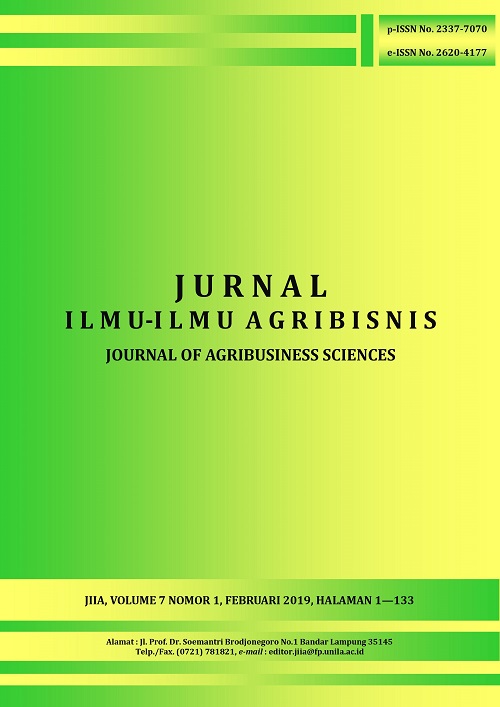ANALISIS EFISIENSI PEMASARAN GABAH DAN NILAI TAMBAH BERAS DI KABUPATEN PESAWARAN
DOI:
https://doi.org/10.23960/jiia.v7i1.3325 Abstract View: 1187
Abstract View: 1187
Abstract
This research aims to analyze the efficiency of paddy marketing system and value added of rice in Pesawaran District. This research was conducted by survey method. The research location is chosen purposively i Kota Jawa Village and Gunung Sari Village, Way Khilau Subdistrict Pesawaran District with consideration that the location is one of the central of paddy production. The samples of this research were 51 paddy farmers who were selected by simple random sampling. The research data was collected in June–July 2017 and analyzed by descriptive and quantitative analysis. The method used in this research is the analysis of the model of S-C-P (structure, conduct, and performance) and used Hayami method to determine the value- added of the rice. The S-C-P model was used to analysis marketing system efficiency. The results showed that paddy marketing system in Pesawaran District was efficient, it could be seen from the producer’s share who greater than 50%. There were three rice milling unit (RMU) in research location and all of that rice miling unit gave a positive value-added to owner.
Key words : efficiency, rice, S-C-P models, value-addedDownloads
Downloads
Published
How to Cite
Issue
Section
License
Authors who publish with this journal agree to the following terms:
Authors retain copyright and grant the journal right of first publication with the work simultaneously licensed under a Creative Commons Attribution License that allows others to share the work with an acknowledgement of the work's authorship and initial publication in this journal.
Authors are able to enter into separate, additional contractual arrangements for the non-exclusive distribution of the journal's published version of the work (e.g., post it to an institutional repository or publish it in a book), with an acknowledgement of its initial publication in this journal.
Authors are permitted and encouraged to post their work online (e.g., in institutional repositories or on their website) prior to and during the submission process, as it can lead to productive exchanges, as well as earlier and greater citation of published work (See The Effect of Open Access).














